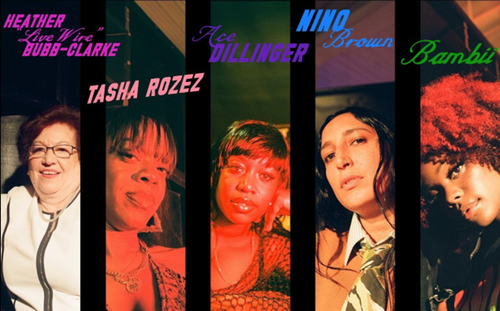
Rewind/Forward: Resynthesizing Sound System Culture in Toronto’s Queer and Female Caribbean Diaspora
Sound system culture has evolved so much since its inception, it’s impossible to offer a complete history. Sound systems originally functioned as promotional tools. The PA system was innovated by Jamaican electrical engineer Hedley Jones who used British Radio technology he became familiar with during the Second World War to amplify bass frequencies to much higher levels. The attention that the speaker box’s sonic impact drew turned sound system culture into a competitive arena and a holistic art. Soon there were sound clashes which incorporated technology, fashion, dance moves, the crowd’s response, and vibes (Henriques, 2011) into the sound system.1 The vibes and cultural practices that originated in Jamaica migrated overseas to various diaspora, including Jamaican-inspired sound systems in the UK, Brazilian aparelhagem, Mexican sonideros, and Colombian picos, among others.
In Canada’s sound system diaspora, the very concept of a sound system is being reinvented. Toronto-based Jamaican-Canadian DJ and producer Bambii maintains that "any sound, ethos… any sort of collective of people that are pushing a sound, pushing a culture, pushing (an) ethos around music, that's a sound system." Reflecting on the evolution of sound system culture through Bambii’s expanded concept of "sound system as movement" inspired me to consider the ways in which Toronto’s female and queer-run sound systems have led the city’s sound system resynthesis, taking up sonic space and remixing sonic practices"
I began writing this piece during a recent trip to sound system’s and my late father’s home country, Jamaica. There, I became sharply aware of sound system culture’s shifting traditions when I entered the grounds of the Jam One Sound System Federation. Walking down the Kingston road, past the zinc fence with the word "woman" spray painted on it, into the ring of sound propelled by tall stacks of speaker boxes, and coming face-to-face with a line of sceptical-looking men I didn’t know, I felt ease leave my body.
Jam One is a sound system yard owned by my mentor, Tony Myers, a former cyclist for Jamaica’s national team and a sound technician who was born into the family sound business. Jam One’s layout is as disparate as Tony’s occupational background. It’s an open-air space flanked by speakers, car parts, and ackee trees; part car detailing shop, part barber shop, part kitchen/bar, and, of course, sound system yard.2 This mix-up nature is not unusual. It’s efficient.
For almost a decade, Jam One has been one of the first "homes" I visit on my Jamaica returns. I felt like the yard’s little sister when I apprenticed as a Jam One soundtech during my first-ever trip eight years ago, and it remains a place I can show up uninvited after a long time away and still be greeted with a beaming, grinning, "wha’ gwan?". Tony and the Jam One guys embraced and mentored me from day one. Chave, Tony’s assistant, taught me how to solder and test wires and handed me the saw I used to cut the wood for King Jammy’s refurbished system. "Prof," Jam One’s in-house electronics repairman, recommended the electrician’s study guide that would help develop my engineering knowledge, and Tony regularly quizzed me on the sound’s tuning ("How does this sound to you? How would you fix it?"). It wasn’t just the technical acumen, hands-on sound tech experience, and speaker construction knowledge they shared but also the openness, patience, and generosity with which they shared it.
For all the warm welcome, though, I’ve almost always been the only woman on the premises. And when I did encounter another woman at the yard, she was either working as the interim office assistant or the Chill Spot (on-site bar) bartender, never behind the decks or stringing up the system. It’s possible that the "woman" who inspired the tag on the entrance wall appears in my absence, but in my experience with sound systems in Jamaica, this lack of female presence is not unusual. It’s almost tradition. w The yard’s male-to-female ratio never activated feelings of insecurity in me until my visit this winter. What changed?
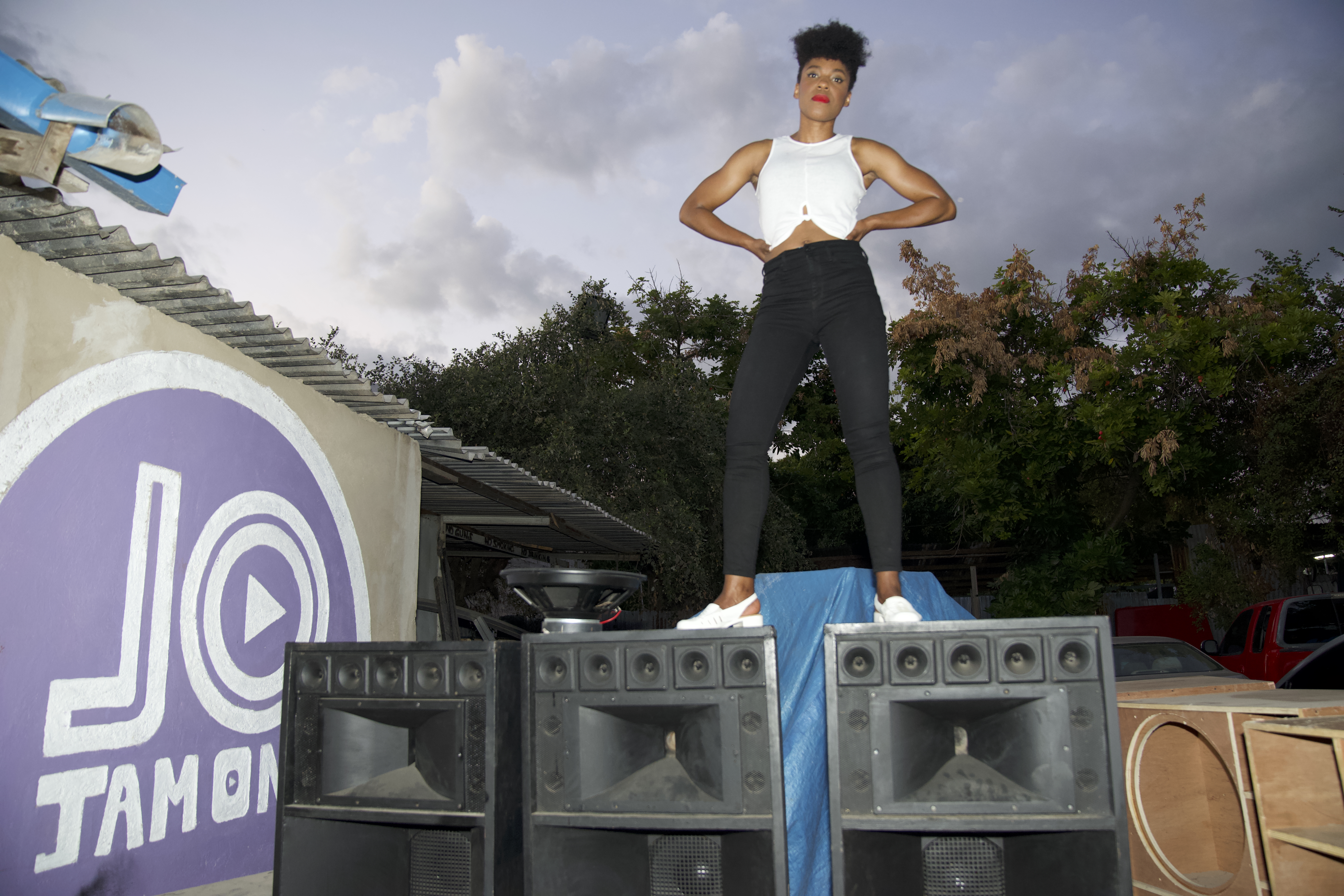 |
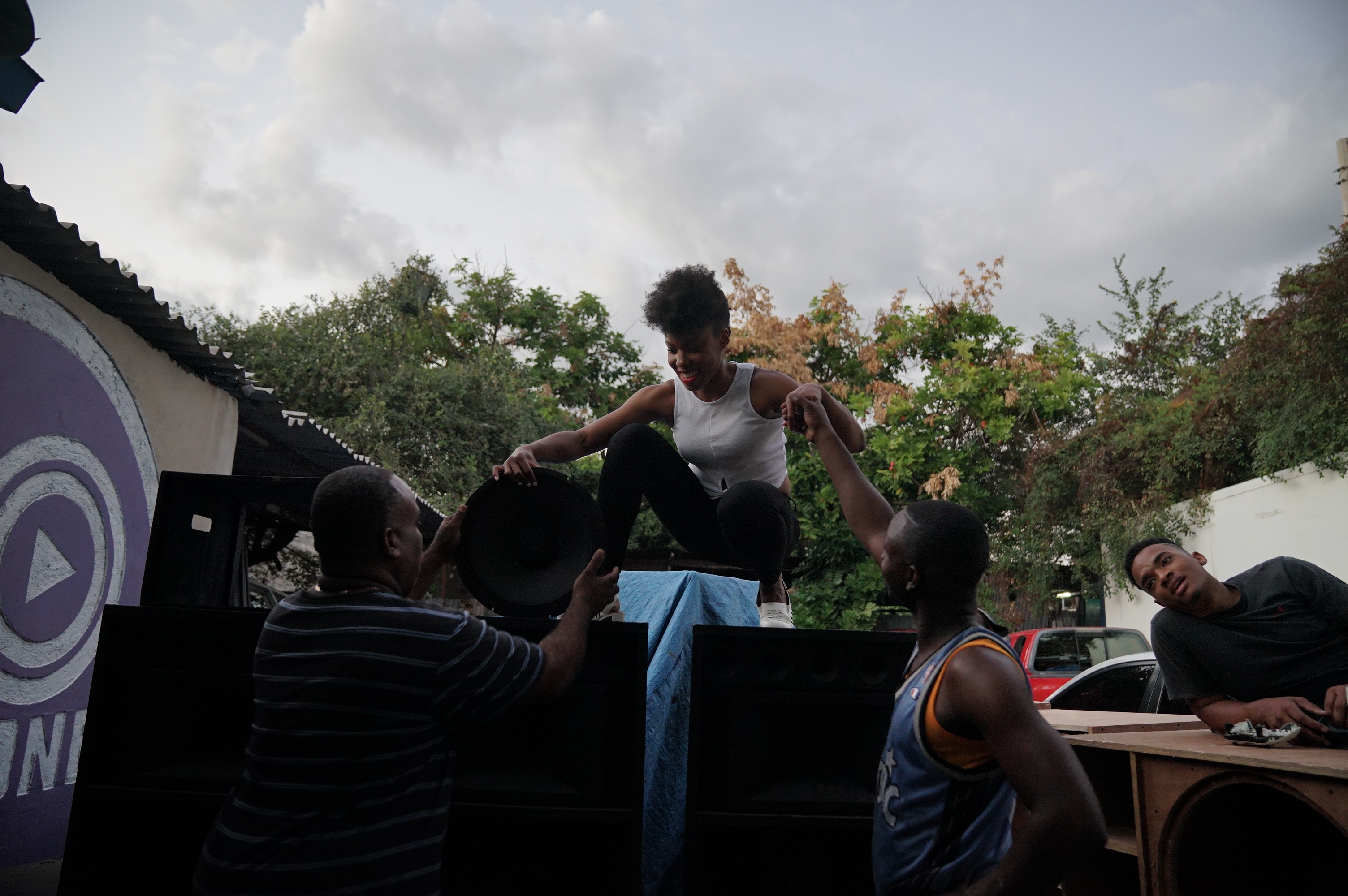 |
|---|---|
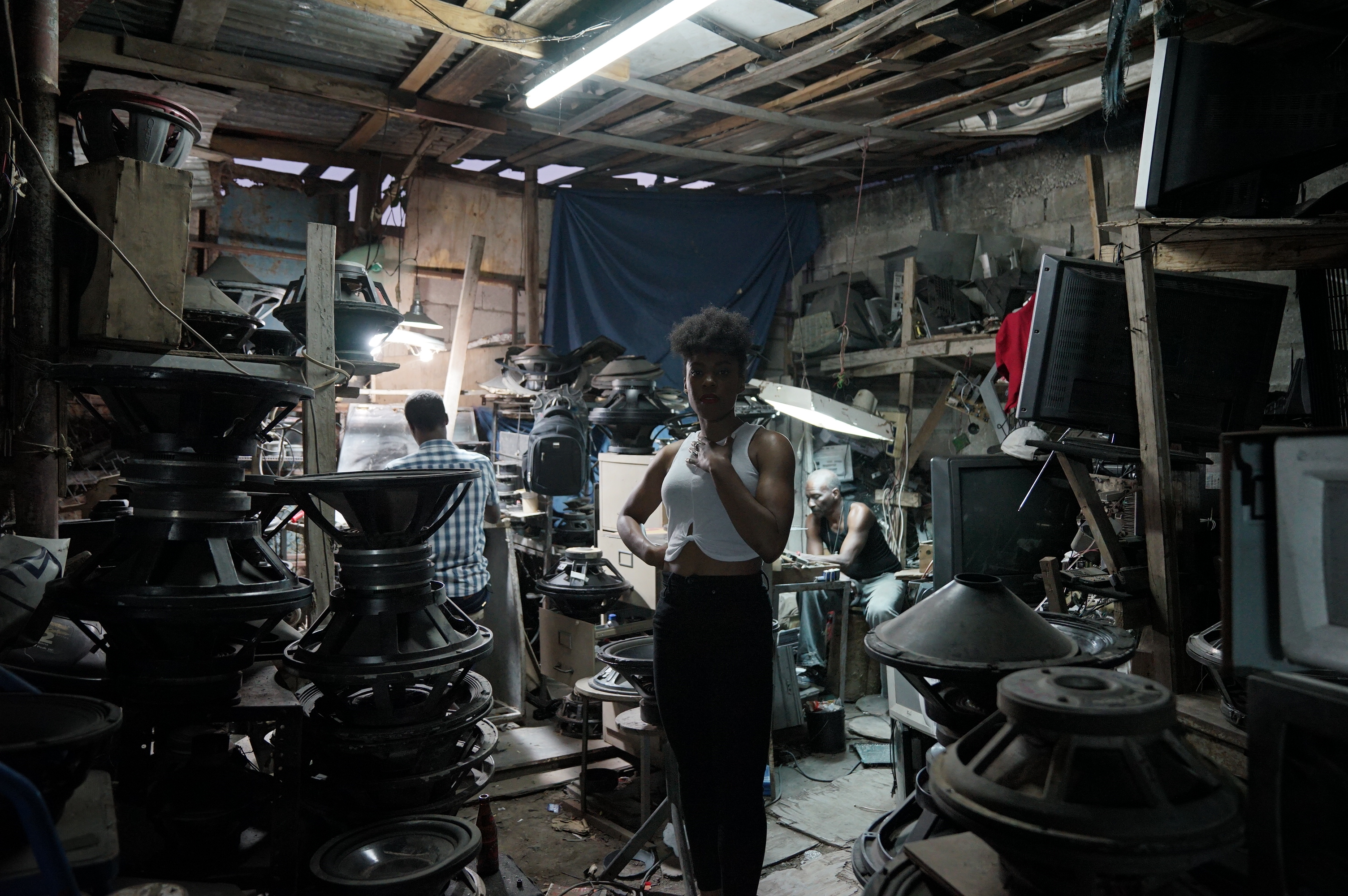 |
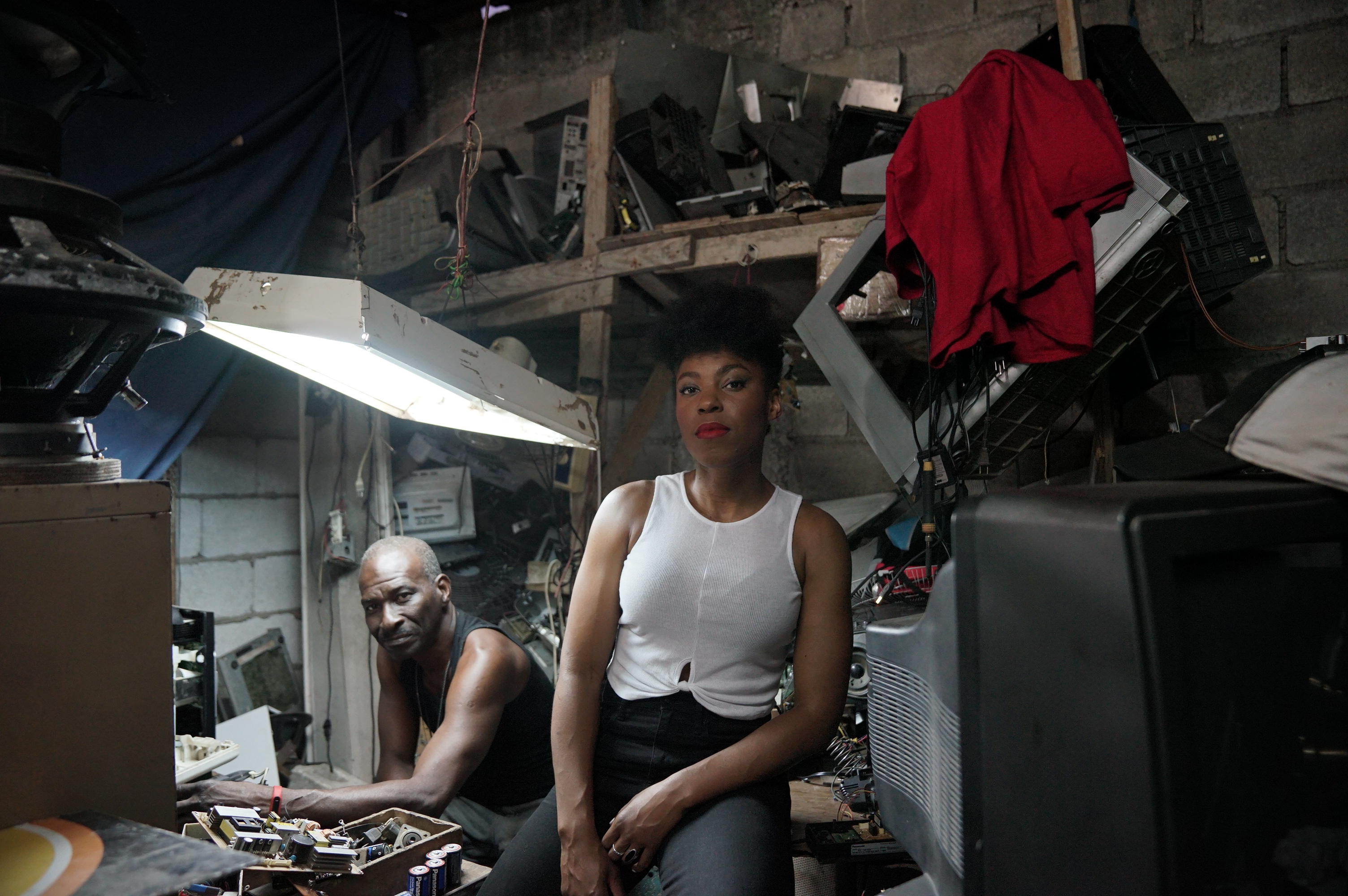 |
Top-left: Alanna Stuart at Jam One, © May Truong
Top-right: Alanna Stuart at Jam One, with Jam One Sound System Federation founder, Tony Myers (bottom-left), and his assistant, Chave (bottom-right), © May Truong
Bottom-left: Inside the Jam One workshop, © May Truong
Bottom-right: Alanna Stuart and Jam One’s electronics repair man who simply goes by "English", © May Truong
Sitting with these thoughts and feelings alerted me to the sound system cultural resynthesis happening in my other home of Toronto, Canada, and how flipping sound system culture isn’t confined to changes in the music being played or the technology sounds play through, but also manifests in the identities of the bodies behind the gear, how they’re curating sound system spaces, and how this impacts how the bodies in these spaces feel. Toronto’s particular resynthesis, and the rare unease I felt at Jam One, speaks to the effect of my scholarly work as a Gender Studies PhD student learning the impact of my own sound system of sorts, a music production ethos that feminises dancehall music production practices. My research explores what happens when my selves – Black, female, Jamaican, Canadian, artist, technician – are moved from the margins to the centre.
In some ways, I have no business talking to you about sound systems. I’m a seasoned music producer and vocalist, but barely a selector. You’ll sooner catch me behind the mixing desk than behind the decks. And, while the Jam One Sound System Federation is home, the studio is where I live. However, my personal journey through Caribbean-Canadian sound exemplifies the diasporic experiences that have led to Toronto’s queer and feminised sound system movements.
Until my first trip to Jamaica eight years ago, my knowledge of sound system culture has been inherent and in a Canadian context. It started in the womb. My Jamaican father and my Grenadian mother, who were both part of Canada’s immigration boom of the 1970s and 1980s, hosted or attended parties every weekend amongst a mix-up crowd of other expats based in my hometown of Ottawa, a predominantly white government town and Canada’s capital city. House parties were a respite from unbearable winters and the foolish racism they endured as one of Ottawa’s first Black public transit drivers (my father) and a domestic worker (my mother).
At the parties, food was set out on the table by 9pm, the music really got going at 11, and they danced til the next morning when breakfast was served. Every weekend, a different household from a different island would open their basement to host, tumbleweeding newcomers into a community. I joke that I gestated on the dancefloor. The story goes: my parents were dancing on Sunday, and my mom went into labour the following Wednesday.
As a toddler, I’d fall asleep to the dull thud of sound leaking from my parents’ basement jams. Canada’s sound regulations meant that sound systems that would traditionally blast across neighbours from open-air venues in Jamaica were restricted to the indoors. I’d later learn how this muting of the sound would mute the culture. In my teens, I remember experiencing adolescent ambivalence towards the random stereo systems my dad would stop to check out on our after-school commutes; I’ve also felt a deep feeling of satisfaction running the velvet record brush across my father’s Stevie Wonder "Boogie On Reggae Woman/Seems So Long" 45. I’d play records from his collection as he prepared escovitch fish and sprinkled slices of bitter melon on salad for dinner.
In my later teenage years, we moved to Malton, a small suburb on the outskirts of Toronto. My Catholic high school was predominantly Jamaican, Italian, Polish, and Filipino. Our Cafeteria served Jamaican beef patties alongside penne alla vodka for lunch. I can still recall the false and awkward sense of womanhood at the Saturday night dancehall parties my fake ID would get me into before graduating from high school. Mr. Vegas "Heads High" or Tanya Stephens "Goggle" were go-to hits. I felt grown whining up on the guy behind me. In those Greater Toronto Area (GTA) venues, heat was generated by the crammed bodies in the enclosed spaces, not the year-round warmth of Kingston’s parking lot venues. The suburban shopping complexes where my early Toronto jams were held resembled the industrial storefront where my Jamaican Pentecostal Church service took place the next morning.
How Does Jamaica’s Music Culture Compare to Canada’s? Jamaican parties may go ’til sunrise, but Toronto’s last call is still 2 AM. Despite the red tape, our selectors discuss how bashments and fetes outside of the city hold a vibe.
On the surface, these personal sonic moments in Canada bear little family resemblance to the proper sound systems and parties I’ve attended in Jamaica, but they are closely related. The amplification of lower bass frequencies, gun finger salutes praising a song selection, and Jamaican beef patties in subway bakeries are artifacts produced in Jamaica. Travelling between Jamaica and Canada moved me to consider how the ways of being that are inherent to Jamaican and other immigrant cultures have become so enmeshed with Toronto daily life that they've become hidden or, even worse, forgotten.
Boomeranging between Canada and Jamaica inspired me to produce Rewind/Forward, a public art project spotlighting Toronto’s obscured sound system culture. I developed the public art exhibition to call attention to the invisibility of the city’s sound system and bass music cultures, and to stimulate conversation on how we typically engage with the Jamaican cultural forms and legacies we’ve inherited.
The exhibit coincided with the 35th anniversary of Canada’s Multiculturalism Act, a ground-breaking policy at the time that promoted an ideology of ethnic and cultural diversity. It sought to acknowledge and protect all members of society, including the new citizens who arrived during Canada’s 1970s and 1980s immigration boom. As London became a hub for the UK’s influx of Caribbean immigrants known as the Windrush generation, Toronto became home to this Jamaican wave, eventually becoming the third largest Jamaican diaspora in the world. But while the Multiculturalism Act promised to "foster the recognition and appreciation of the diverse cultures of Canadian society and promote the reflection and the evolving expressions of those cultures," the immigrants themselves lack the acknowledgment that their customs garner.
Rewind/Forward’s in-person exhibit opened in late summer 2022 with a mix-up crowd gathered around a portable sound system, plantain chips, and coconut water in the historically Jamaican Annex neighbourhood. This location is home to my Jamaican barbershop, Lloyd’s, and formerly the One Love Ital Rastafarian-inspired restaurant where I’d eat jerk tofu during studio breaks. Before One Love, the building was occupied by Joyce’s West Indies, a local Caribbean grocer owned by the Shouclair family. The Bathurst St shop had been home to the Caribbean community since the 1960s before it closed down in 2007 when Carmel Elias Shoucair, the owner, passed. It was a hub for the homesick seeking out patties and rotis. This same building, where Rewind/Forward was exhibited, is still in the family, but the block’s Caribbean presence is faint nowadays, with much of the initial diaspora having moved to the suburbs. The location and its faded Jamaican history was meant to encourage us to consider what happens when a community is disconnected from the place it helped establish.
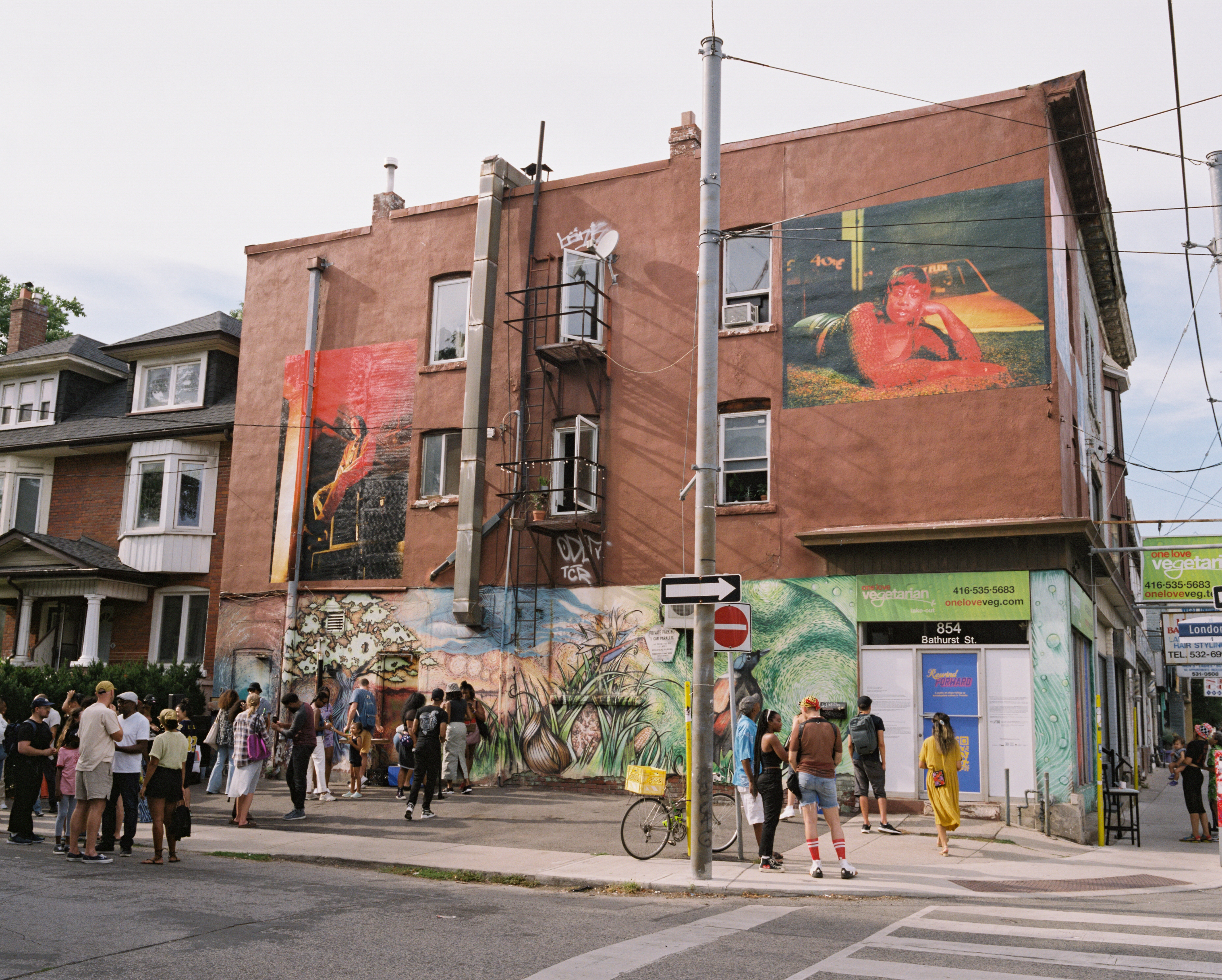
|
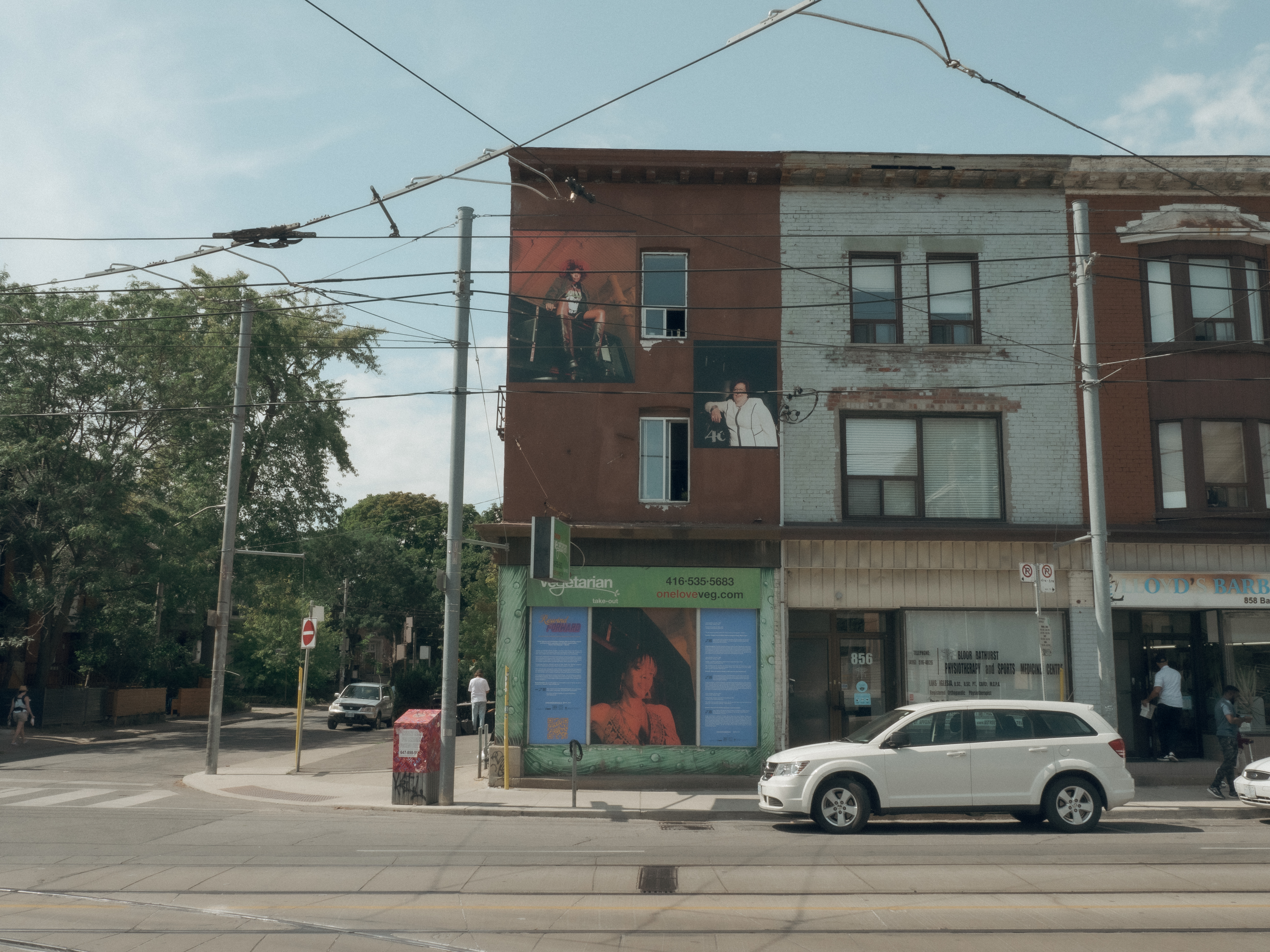
|
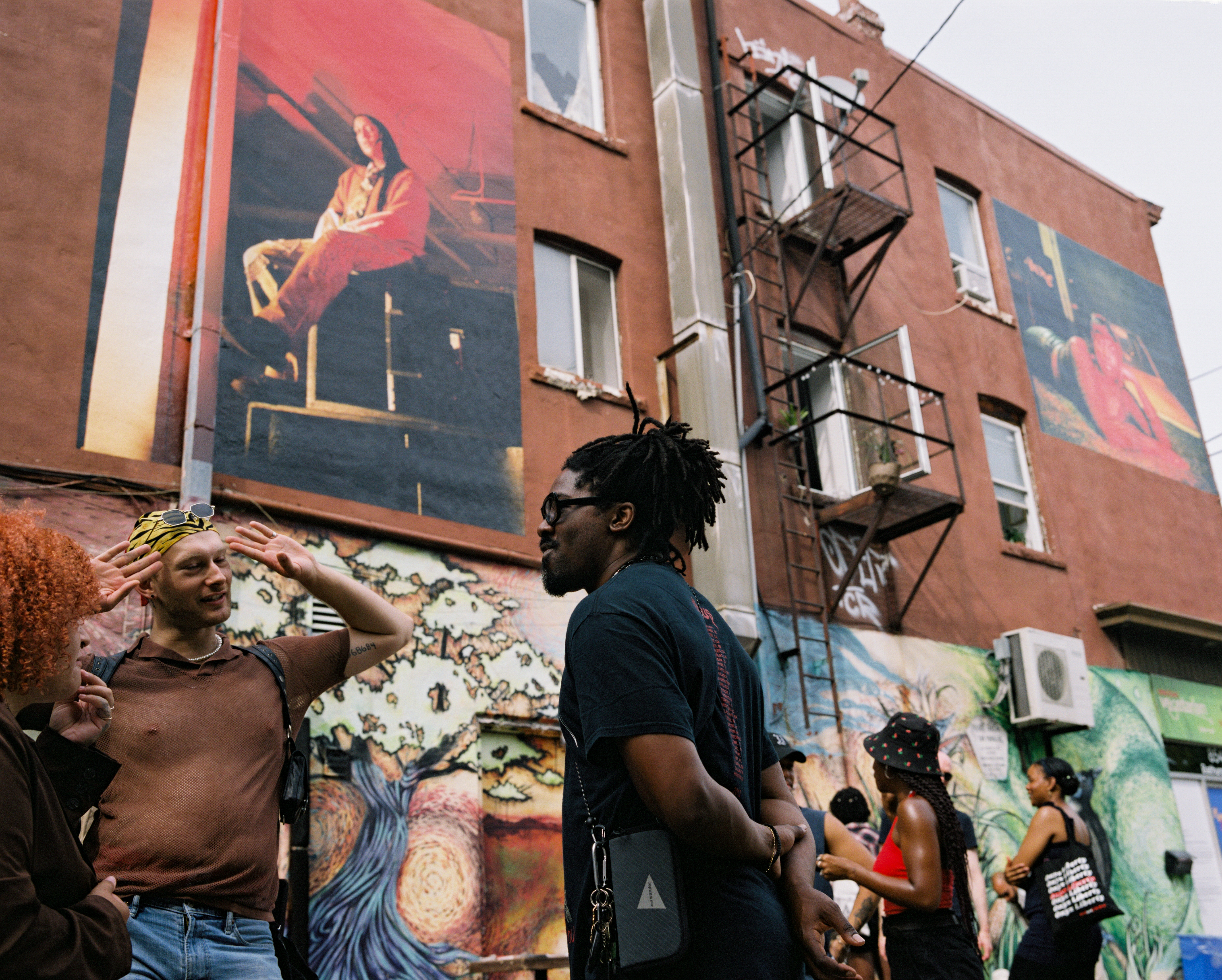
|

|
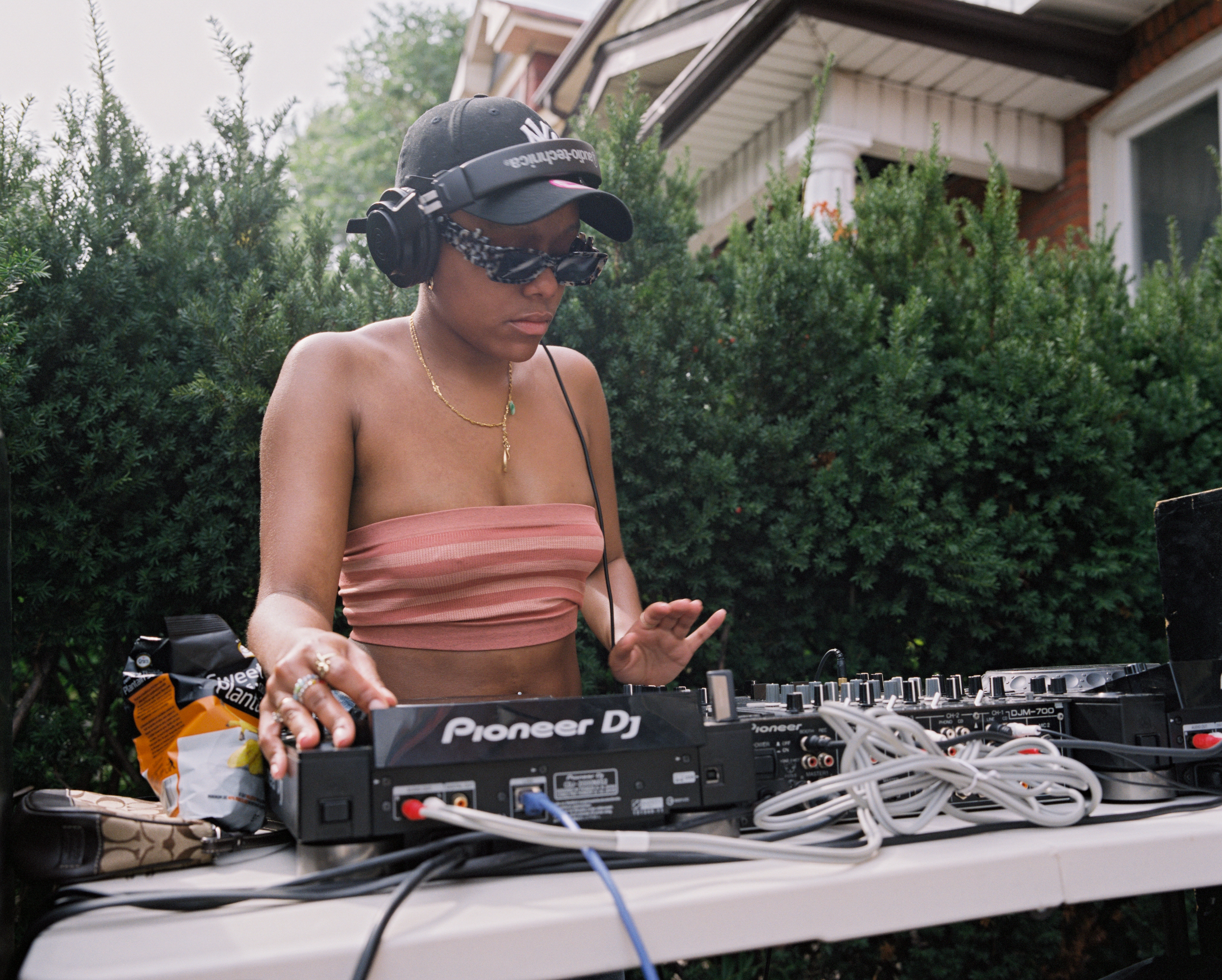
|
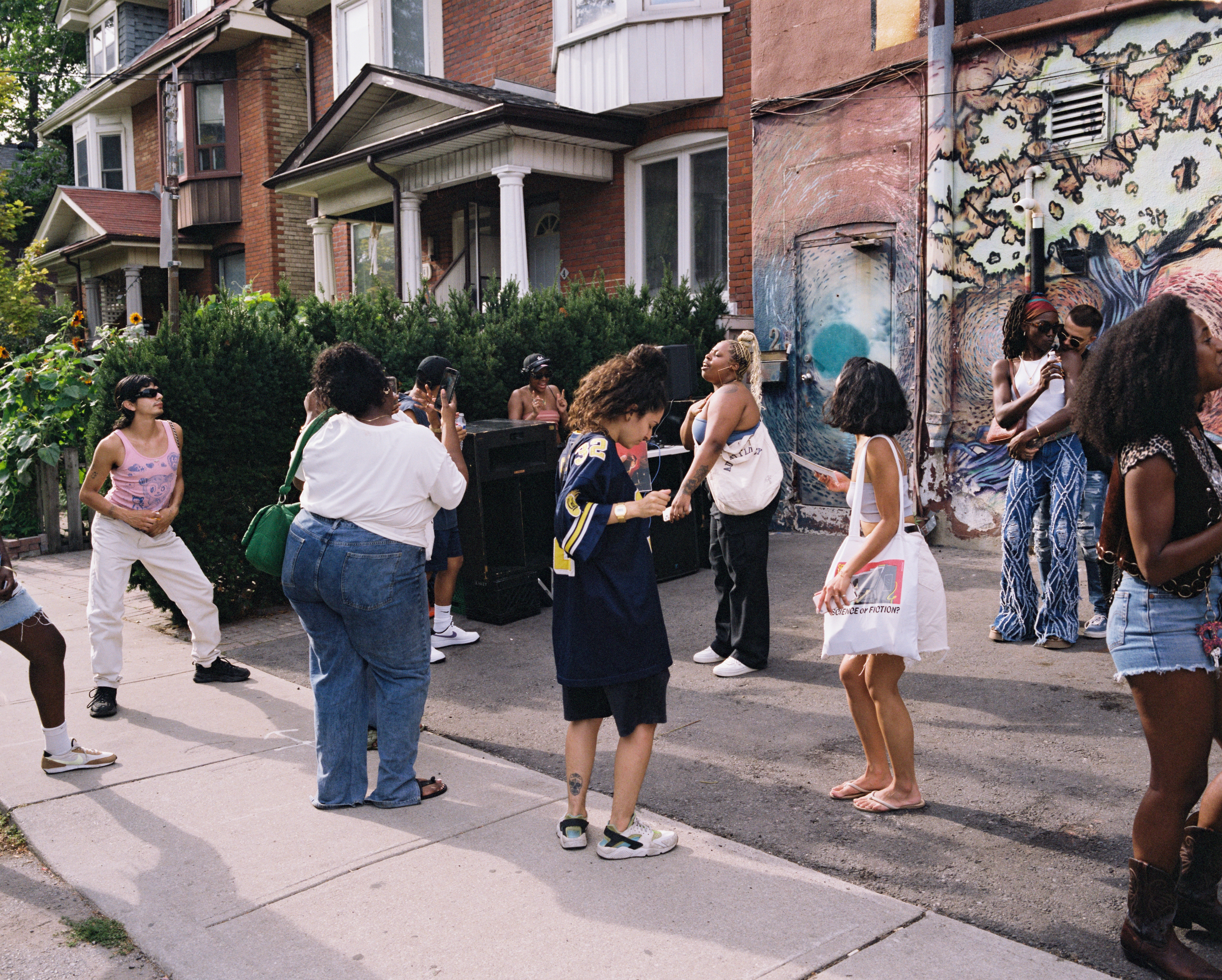
|
Top and middle: Portraits of Rewind/Forward DJs on a building facade in Toronto's historically Jamaican Annex neighbourhood
Bottom: Visitors vibe to DJ playgirl's classic dancehall set
All photos © Colin Medley
Rewind/Forward aimed to magnify Jamaica’s sonic influence on Toronto by mounting monumental portraits on the Annex building’s facade, taken by Jamaican-Canadian photographer Jorian Charlton,3 of five notable Toronto selectors (DJs) and sound system owners: Heather »Live Wire« Bubb-Clarke, Tasha Rozez, Ace Dillinger, Nino Brown, and Bambii. Together, their individual experiences offer a fuller view of local bass music culture: Bubb-Clarke established one of the earliest femme-owned sound systems in Canada after emigrating from Jamaica in the 1970s, and Rozez is one of the district’s only women soundclashers; meanwhile, DJs Ace Dillinger, Nino Brown, and Bambii have built more inclusive nightlife spaces centering queer Black, Brown, and allied people. The selectors’ images were intentionally made large and loud so that their formidable presence paralleled the magnitude of bass music culture's undeniable influence on the city.
None of the five Toronto selectors and sound system owners would identify as the definitive voice of Toronto sound system culture. Nor was Rewind/Forward conceived as a "women behind the sound system" project. I simply reached out to practitioners I’d been inspired by. I had danced to Ace’s, Nino’s, and Bambii’s sets, met "Live Wire" through a friend of a friend who alerted me to the sale of Bubb-Clarke’s system (I am now the keeper of her speaker boxes); and stumbled upon the clips of Rozez’s selections on her social media page, which reminded me of late nights at Weddy Weddy and Passa Passa in Kingston, Jamaica. I realised the collective story their individual narratives told, the tunes they all run and the jams they throw, the communities they check for, and their upbringings, offer different entry points into learning about Toronto’s local bass music culture as a whole.
Part-retrospective, part-forecast, Rewind/Forward’s in-person exhibition was accompanied by a website which serves as a growing archive. With the help of a diverse creative team, I produced several video shorts Toronto-specific sound system perspectives from the views of the featured selectors, custom music mixes by some of the featured DJ’s (the mixes aired on forward dancehall collective Equiknoxx Music’s NTS Radio show), and audio documentaries spotlighting the DJs individual personal and sound community stories. Together, the selectors’ sound systems practices covered a lot of generational ground, spanning pre-Independence Jamaica to Toronto rave futures.
Reflecting on the diversity amongst the almost 350,000 Toronto residents of Caribbean heritage (according to the 2016 census), presenting Rewind/Forward was an opportunity to nuance Jamaican music culture by viewing its Canadian offshoot through an intersectional lens. From this perspective, the exhibition not only placed Canada’s sound system diaspora along the sound system continuum through the selectors’ stories, it highlighted how women and queer folks are advancing sound system traditions.
Heather Bubb-Clarke’s story: "When I went to house parties here, nobody had any music. Here by 12 o'clock you had to tone down the—the music, that kind of thing. Most events were shut off by one o'clock, even New Year’s Eve! Selecting at a party in Jamaica, you know it was Jamaican music, right? We could play till two, three o'clock in the morning, nobody trouble you. You could play ‘til the cows come home—the cow dem would dance, too, right? (Laughter)." More information, interview transcript, and image description: https://www.rewind-forward.ca/heather-bubb-clarke
Tasha Rozez’s story: "Chante and I are Gunz N Rozez, originally. We came from a male dominated industry of hanging with DJs and guys. We were the roses amongst – not the literal guns – but the men, the hardcoreness. Of course it was a song that Bounty had – Bounty Killer, which spoke about females from a uptown region, which is what Chante and I would consider ourselves." More information, interview transcript, and image description: https://www.rewind-forward.ca/tasha-rozez
In one of the_ Rewind/Forward_ mini-documentaries, I asked the selectors who they thought was forwarding Toronto’s sound system culture. Canada’s first female-run sound system and Jamaican elder, Heather "Live Wire" Bubb-Clarke, said that forwarding sound system culture is "up to the next generation." This forwarding is felt in Toronto’s queer dancehall cultures cultivated by selectors like Ace Dillinger, Nino Brown, and Bambii. Ace Dillinger, a selector of the younger generation, says that it’s the queer community, specifically: "Unfortunately for the people who don't like queer people, queers are taking over. Sorry to tell you. And we are the ones that are like helping push culture and music and innovation and fashion and all of these things forward. that's never gonna change and that's never gonna stop when queer people are always gonna be there. So like, it would be really cool to be able to like, feel the sense of sound system culture."
Ace’s proposal for a more inclusive sound system culture speaks to the positive impact of the contemporary sound system synthesis in Canada – shifting the feeling of the culture by creating space for and recognising those who are overlooked and excluded. That uneasy day at Jam One is an example of how it can feel to navigate a traditionally hyper-masculine sound system space, which is common in most male-dominated sound cultures. What would it mean, then, to resynthesise the feeling and identities within these spaces?
I conceive of resynthesis as disidentification, which is a strategy for finding one’s own voice or sense of self within a culture in which one may actively participate in but may not always be welcomed, recognised, or even safe in. This is especially true in the case of those whose identities reside outside the racial and sexual mainstream. Disidentification works "within and outside the dominant public sphere simultaneously." (Muñoz) Rather than a binary stay-or-go approach, disidentification enables one to participate within a cultural group and recognise oneself as part of a culture without necessarily accepting its problematics. Leaving the culture risks erasing one’s presence from it when, as in the case of Toronto’s queer dancehall diaspora, women and queer folks are active contributors to Jamaican sound system culture, too. Instead, one stays and transforms it from within by building new cultural worlds.
Disidentification recognises Ace Dillinger, Nino Brown, and Bambii’s queer dancehall parties as a sound system culture that is "the same, but with a difference" (Muñoz). When I’ve gone to their parties, I’ve heard dancehall classics and clever do-overs (covers) blasting same way. You might hear Ace Dillinger playing house alongside dancehall to »give them something else, "or Bambii taking"…a Britney Spears vocal and putting it with some other shit…or taking some kind of Tik Tok song "in a way that »cuts the seriousness."
Ace and Bambii’s sonic play extends from the Jamaican music culture from which they both descend. Jamaican popular music culture (JMP) is a vibes-driven culture. It’s said that this "no guilty pleasures" approach to music is an extension of JMP’s history of rejecting authoritative policing of taste (Macleod, 2015). So, it never surprises me to hear plenty of Celine Dion alongside Berres Hammond and Vybz Kartel blasting through the Stone Love’s sound system during their weekly Weddy Weddy parties in Kingston.
Who’s helped shape Toronto’s sound system culture? Who’s helping or stopping it move ahead? Selectors rewind (and fast forward) Toronto's party possibilities.
Ace, Bambii, and Nino are actively participating in their Caribbean music traditions. At their queer parties, bodies whine up, bass rattles, sweat flails, and slackness »skin out«. It’s not entirely different from what I’ve seen in Jamaica, or at Carnival in Trinidad. The sonic, technological, and even culinary components are all present in Toronto’s queer dancehall parties and sound systems (Bambii serves jerk chicken at hers), but the identities of the bodies whining, and the bodies they’re whining up against, wouldn’t be commonly seen together so openly in downtown Kingston.
Music artist and queer diasporic sound scholar, Casey Mecija says that queer diasporic sounds, like Nino, Bambii, and Ace’s sound systems, invite us to "listen for something more, "beyond the gendered and sexualised tropes of the homophobic Jamaican mapped across the community. The act of listening for something more fosters feelings of belonging within the diaspora by creating an opportunity to listen for the aspect of their 'selves' within sonic cultures that, when experienced on the surface level, excludes queer folks. Queerness is not solely a sexual identity, but also a methodology, a way to counter, critique, or break from the norm. Queerness is produced when "the conditions of sound-making offer a lifeline to differently understand the sounds we take for granted." (Mecija, 2020)
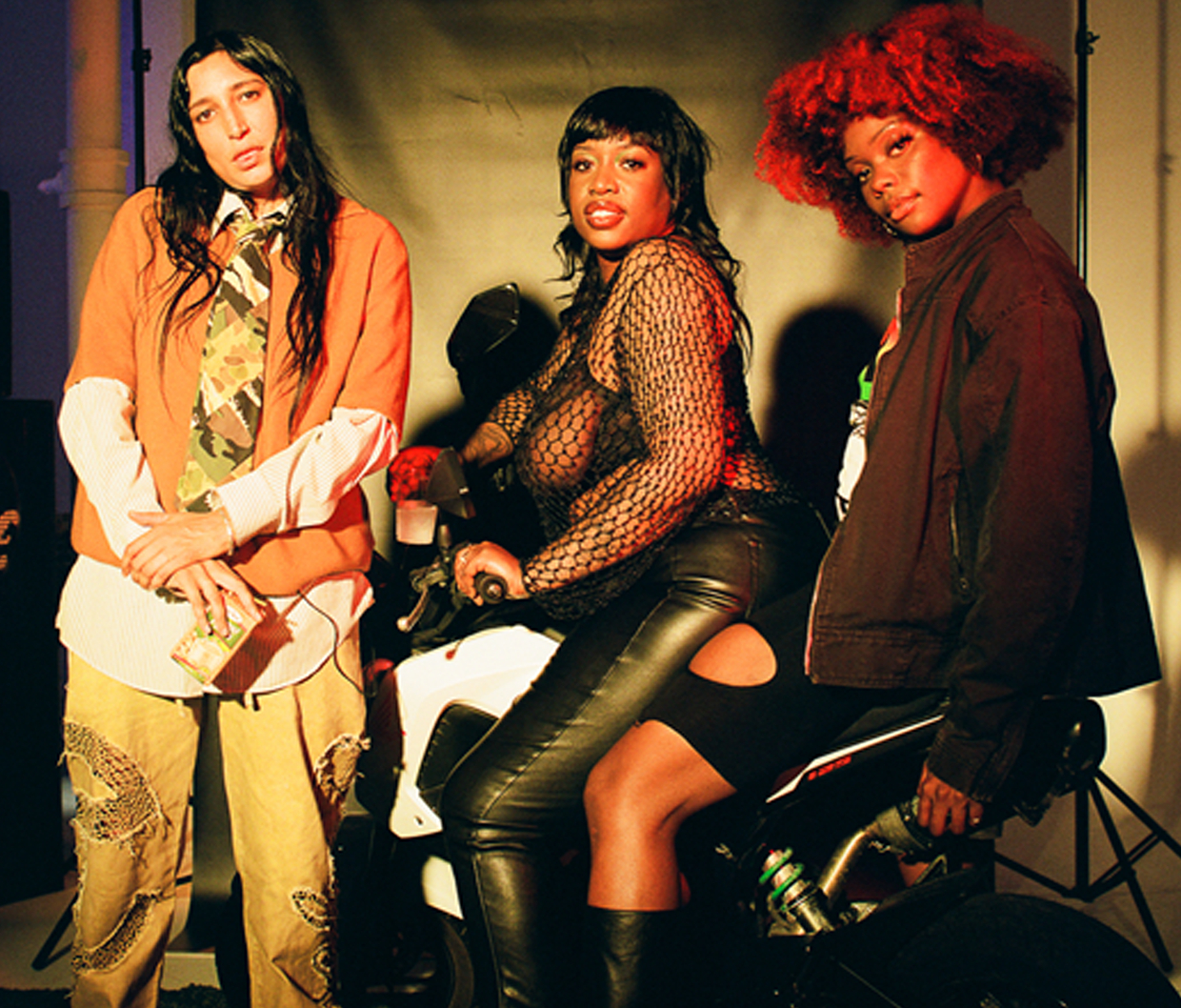
Revisiting Ace Dillinger, Bambii, and Nino Brown’s very Caribbean and specifically queer sound system perspectives illuminated how bass music culture is expressed in Toronto’s diasporic dancehall everynight life and places, as well as the impact of these resynthesized sound systems "playing telephone with history" (Chung, 2019). Their stories convey how these selectors and sound system cultivators honour and build on the Jamaican sound system traditions, all while expanding sound system culture’s social possibilities by queering the culture’s social conventions.
Ace Dillinger shares her genre expansive approach to DJing sex positive parties in Toronto such as BI PANIC AT THE DISCO. "I like to try and play house music in my sets, when I know people are probably used to just wanting to hear dancehall. Like I wanna, you know, give 'em a little something else. I think it's important to me to introduce new sounds to other people because I don't like the idea—or there was an idea, I felt, that like when you are Black, you like these things, and you have to like these things only..."
Ace’s story also shows how being unabashedly out is the most dancehall thing you could do: "I can't worry about that because then who would I be? I'm going to be queer, regardless if you know it or not, the same way I'm Black everyday. I can’t shy away from that…I'm not like, 'I need to represent for all the Black queers' – that's not me – but I’m also, not scared to say like, 'no, I'm hella gay.'"
Ace Dillinger’s story. More information, interview transcript, and image description: https://www.rewind-forward.ca/ace-dillinger
Rewind/Forward also reminded me of the natural gestures of care at queer parties that disidentification identifies as a "negotiating the gap between the toxic politics of the dominant ideologies they can identify with, and the change or 'difference' needed to make those positions safer, and ›good‹ for them." (Muñoz, 1999)
Nino Brown shares how parties like Yes Yes Y’all actively cultivate feelings of positive feltness practices (art making practices based on care, emotional intimacy, and responsibility) and safety within in the queer and racialized bodies of folks participating in contemporary Canadian sound system culture: "There is a spirit of competition when it comes to sound system culture, which is something we tend to eliminate in—when we're doing more inclusive parties. You know, it’s like, meant to not have that competition with each other. So, I think some of the spirit gets lost in that, and sometimes I'm like, is that erasure or is that just evolving? I think before there was a little more seriousness, and being a purist was kind of like idolised, whereas now people have more fun with it. And that, I think, is a product of queer dance parties."
Nino Brown’s story. More information, interview transcript, and image description: https://www.rewind-forward.ca/nino-brown
Bambii’s JERK party simultaneously resynthesizes sound system culture and defies the myth of the homophobic Jamaican by explicitly prioritising the queer Caribbean community. While Bambii recognises the need to make space for the queer community within her Caribbean community, she warns against reinforcing the homophobic Jamaican stereotype, and, instead, identifies her dancehall party as a natural evolution of the true nature of sound system culture. Her story celebrates her Caribbeanness while expanding its social confines: "Dancehall is a really powerful art form and it's mine to sift through and take what's good from it, and leave the bad. Like someone like Vybz Kartel is like a ridiculous, iconic figure in Jamaican music, but like we love him (laughter), but he's crazy! Like from the bleaching, to the homophobia, to the violence – I don't think that's Caribbeanness. People from all over the world who have traditional aspects of their culture that are problematic have to make those reconciliations."
Bambii’s story. More information, interview transcript, and image description: https://www.rewind-forward.ca/bambii
Ace, Nino, and Bambii’s sound system practices make space and challenge norms while holding a vibe. Their sound systems function as a movement; the sonic power of the speaker box and bass to draw bodies closer together creates an opportunity to unify folks around a shared ethos of community, care, and joy. These sound systems exemplify the myriad of ways that BlPOC women and queer folks – who often face the greatest obstacles to accessing sonic technologies and music career opportunities – circumvent barriers to innovate sound cultures around the world.
Queering and feminising sound environments through presence, technology, care, and vibes, resynthesizes sound system culture by establishing what Katherine McKittrick calls demonic spaces (McKittrick, 2006) – sites that reconfigure social spheres by decentring dominant and normative ways of being, making, and collaborating. Black women, especially, working as producers of hybridised sounds in the studio, community builders behind CDJs, and writhing, embodied performers on (but not for) institutionalised stages have used "loopholes of retreat" – the studio, the stage, the dancefloor – to challenge norms simply by occupying roles and spaces they’re not expected to be in (McKittrick, 2006). Rewind/Forward selectors Heather "Live Wire" Bubb-Clarke and Tasha Rozez are not queer, but their presence in their respective scenes aren’t the norm either. Live Wire’s sound was assumed to not have enough power because she’s female. Tasha was the only woman in the sound clash of the early 2000s, but she reppe’d the same way.
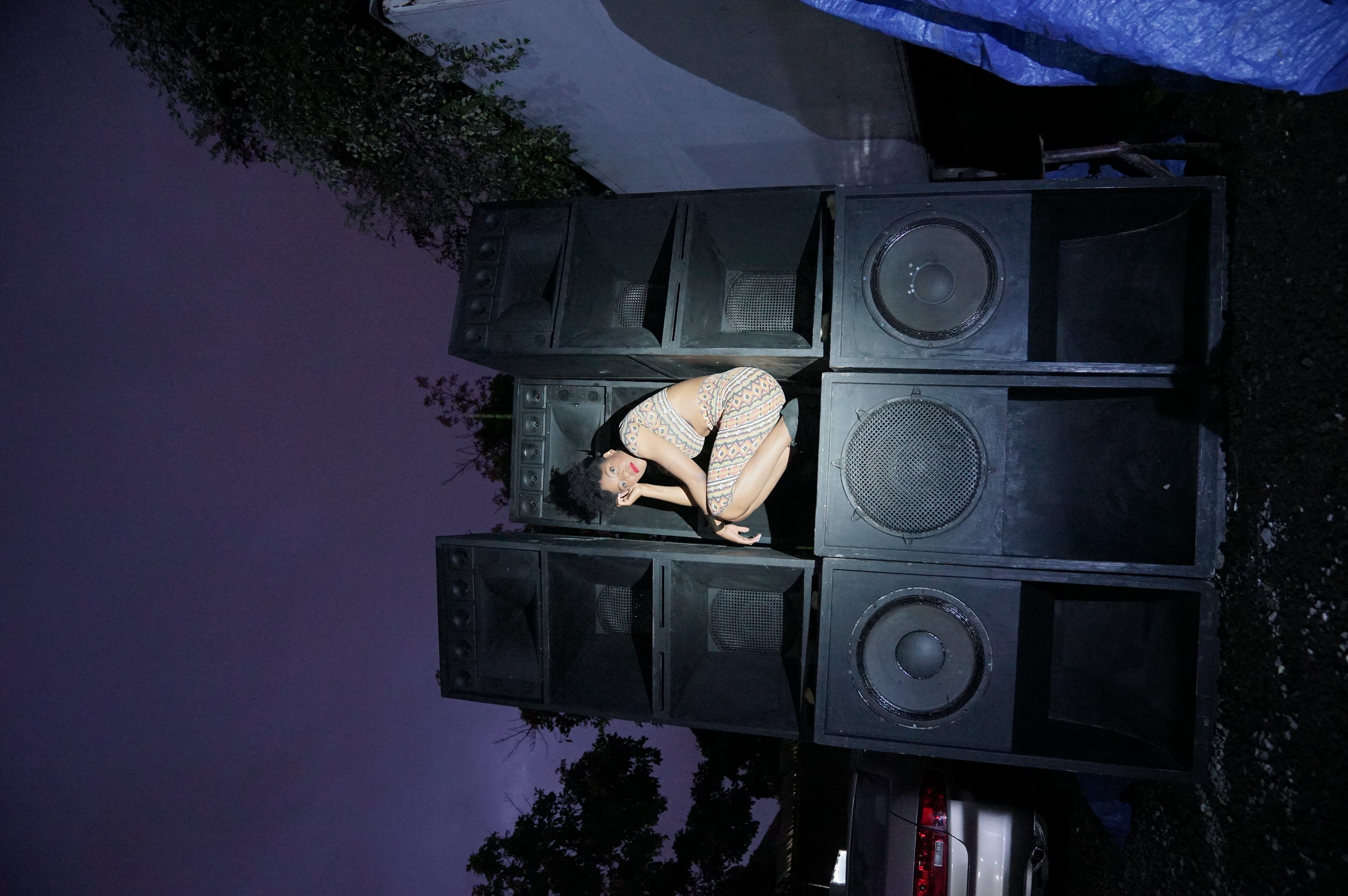 |
 |
|---|---|
Alanna Stuart performs her Femmehall sound as PYNE, © May Truong
In the UK, London’s Black Obsidian Sound connected a community of queer, trans and non-binary black and people of colour by building on sound system legacies, but in a way they could learn, expand and sustain a sonic resource through activist art. Montreal’s newly developed MORPH Sound, started by future-dub producer, selector, and "sound system mom" Honeydrip (aka Tiana McLaughlin), equips women and queer folks with the technical skills and confidence to build, own, and shape their own soundscapes. MORPH recently provided hands-on learning in speaker construction, from soldering to assembling cabinets and testing fully functional sound systems. DJ and community programmer Gaby D’Annunzio curated a whole day’s worth of programming dedicated to women across generations who are "reshaping the physical and spiritual architecture of sound system culture, creating compassionate spaces and inspiring future generations."
And my own Femmehall (feminized dancehall production practice) as PYNE could be considered a sound system, or a new movement that builds on dancehall production traditions: prioritising kick and bass, but expanding it by utilising vocal production to give emotional vulnerability equal weight.
Across all of these movements, similar to female hip hop DJs in the US, women and queer selectors, producers, and performers, demonstrate the "masterful (re)mix of gendered, racist hierarchies that would otherwise impede women’s visibility, impact and social imaginations in racist and masculinist contexts that attempt to deny their full humanity." (Craig & Kynard, 2017)
How Would You Describe Your Sound system Culture? Dubplates, massive-ass speakers, a crowd. Ranging from the analogue to the digital, Rewind/Forward selectors share their setups’ varied sonic and socio-political components.
How we produce and consume sound is a consideration for how we live (Sterne, 2012). Or, as legendary Jamaican drummer and producer Sly Dunbar put it: "music is life." So, when I’m thinking about how my body (a carrier of information) impacted the Jam One space that day, I’m thinking about how it feels to move through the world in the body I’m in as well as what it meant for me to be the only woman in the yard. Having opportunities to wield and remix the music-making techniques and technologies that determine how sound is experienced brings me beyond simply observing these feelings, though. By producing and performing music, and creating music spaces, I am actively developing ways to unbother my body (maintaining my body’s sense of agency) in the presence of others and in the face of discrimination and social imbalances.
I finished writing this piece in Canada, where I’m starting to prototype a music production studio inspired by the sonic unruliness of dancehall studios I’ve worked in in Jamaica. The studio space considers tense moments like at Jam One, but instead looking to the Jam One guys and asking them "what changed?" I’m interested in looking inward, in a very dancehall way, and asking, "what do I want to change? What would a space need to have to unbother me?" These are the questions and curiosities I see being addressed, that I feel being accounted for when I bruk out at the Rewind/Forward selectors parties, when I air out their mixes, when I test tunes through their systems. Resynthesizing sound system culture through the queer and feminine diaspora creates moments of unbothering that feeds rather than depletes my body of ease.
To be clear, this sense of agency is not a departure from the joyful rebellion of Jamaica’s sound system cultural history, though. Like the creators of Jamaican-British musical offspring grime, the femme and non-binary queer, Jamaican-Canadian diaspora has employed the sonic influence of dancehall sonic production techniques and aesthetics to build on Jamaican atmospheres of sound through the use of bass, effects, and Jamaican patois. We can call it resynthesis, disidentification, queerness of sound, or demonic spaces, but all of these parties were inspired by the sound system culture they’re challenging. Jamaican popular music’s history of unruliness and critique, and overturning of conventional Western music practices, provide the tools for Bambii, Nino, and Ace’s own joyful rebellion. Bambii reminds us that "… when we look back historically at what a sound system was, people focus on the physical, but the fact of the matter is sound system culture was about politics. It was about individual people communicating with their community, and people are still doing that. It just looks a bit different."
Suggested Listening
Heather »Live Wire« Bubb-Clarke’s NTS mix: https://www.nts.live/shows/equiknoxx/episodes/equiknoxx-26th-october-2023
Tasha Rozez’s NTS mix: https://www.nts.live/shows/equiknoxx/episodes/equiknoxx-28th-september-2023
LINK - Ace Dillinger’s NTS mix: https://www.nts.live/shows/equiknoxx/episodes/equiknoxx-23rd-november-2023
References
Erin Macleod, »Nice'n'easy listening: why Jamaica loves Celine Dion and Air Supply,« The Guardian. 21 Maz, 2015, https://www.theguardian.com/music/2015/may/21/why-jamaica-loves-easy-listening-celine-dion-air-supply.
Jonathan Sterne, ed., The sound studies reader (Routledge, 2012).
Jordan Chung, "Playing Telephone with History," Talkhouse. May 28, 2019, https://www.talkhouse.com/playing-telephone-with-history/
José Esteban Muñoz, Disidentifications: Queers of color and the performance of politics (University of Minnesota Press, 1999).
Julian Henriques, Sonic bodies: Reggae sound systems, performance techniques, and ways of knowing (Bloomsbury Publishing, 2011).
Katherine McKittric, Demonic grounds: Black women and the cartographies of struggle. (University of Minnesota Press, 2006).
Todd Craig & Carmen Kynard, "Sista girl rock: Women of colour and hip-hop deejaying as raced/gendered knowledge and language," Changing English 24, no 2 (2017): 143–158, https://doi.org/10.1080/1358684X.2017.1311034.
Casey Mecija. "The sound of queer diaspora: Sonic enactments of Filipinx desire, loss and belonging." PhD diss., University of Toronto, 2020.
Bio
Alanna Stuart is a Caribbean-Canadian artist and researcher who as PYNE is currently in the thick of what she dubs a »Femmehall« practice: a feminine approach to dancehall production. She has produced Jamaican music legends Sly & Robbie, and collaborated with Junior Boys, U.S. Girls, and others. Her PhD research uses dancehall’s unruly production processes to explore what happens when the experiences of Black women music makers are prioritised in music spaces.
This text was commissioned as part of CTM 2025
-
A sound clash is a battle between two sound systems. Sound system selectors play only dub plates, which are custom re-recordings of a music artist’s original song. The dub might include new lyrics that identify or big up the battling sound system. The battle involves each system playing their dubs with the crowd as judges. Whoever's songs get more "forwards" (crowd noise), wins the battle. ↩
-
A sound system yard is a place where you’d usually go to build, repair, or test your system’s technical components. At Jam One’s yard, you could sip a Magnum Tonic or get your car Turtle Waxed as you waited for your speaker box to get refurbished. Learn about the various forms a sound system or sound system yard can take via Sonic Street Technologies (SST). The SST research team is building a global map of sound systems around the world, aiming to "to investigate the social, economic and cultural conditions from which sound systems, like Jam One’s, are born; and to achieve a deeper understanding of the nature of technology itself." ↩
-
I came to know Jorian Charlton through her work photographing Toronto’s queer rave scene. In her photo exhibit, Out of Many, her documentation of Jamaica’s Toronto diaspora of today is presented alongside her father’s photo-documentation of his migration from Jamaica to New York City and Toronto in the 70s. ↩